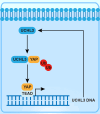UCHL3: a crucial deubiquitinase in DNA damage repair and tumor progression
- PMID: 40691601
- PMCID: PMC12278599
- DOI: 10.1186/s12935-025-03884-x
UCHL3: a crucial deubiquitinase in DNA damage repair and tumor progression
Abstract
Ubiquitin carboxyl terminal hydrolase L3 (UCHL3) is a deubiquitinase belonging to UCH protease family. Previous studies have demonstrated that abnormal expression of UCHL3 is correlated with the development of human diseases, especially in tumors. Notably, UCHL3 exhibits contradictory biological functions across different cancer types. Initial studies identified UCHL3 as a tumor suppressor in prostate cancer. However, emerging evidence suggests that UCHL3 serves as an oncogene in other cancers. Several UCHL3 inhibitors have shown a promising anti-tumor effect in vitro and in vivo. UCHL3 has also been linked to DNA damage repair, which is essential for genome stability. Overexpression of UCHL3 enhances DNA damage repair induced resistance to chemotherapy or radiotherapy in certain tumor types. This review aims to summarize the promoting role of UCHL3 in DNA damage repair and its dual, paradoxical roles in tumor progression, along with the associated mechanisms, and to provide insights into the use of UCHL3 as a therapeutic target for overcoming DNA damage repair-mediated resistance to chemotherapy and radiotherapy, as well as for treating tumors.
Keywords: Chemoresistance; DNA damage repair; DNA damage response; Deubiquitinase; Radioresistance; Tumor progression; UHCL3.
© 2025. The Author(s).
Conflict of interest statement
Declarations. Ethics approval and consent to participate: Not applicable. Consent for publication: All authors contributed to revisions and approved the final manuscript. Competing interests: The authors declare no competing interests.
Figures





Similar articles
-
Management of urinary stones by experts in stone disease (ESD 2025).Arch Ital Urol Androl. 2025 Jun 30;97(2):14085. doi: 10.4081/aiua.2025.14085. Epub 2025 Jun 30. Arch Ital Urol Androl. 2025. PMID: 40583613 Review.
-
Short-Term Memory Impairment.2024 Jun 8. In: StatPearls [Internet]. Treasure Island (FL): StatPearls Publishing; 2025 Jan–. 2024 Jun 8. In: StatPearls [Internet]. Treasure Island (FL): StatPearls Publishing; 2025 Jan–. PMID: 31424720 Free Books & Documents.
-
UCHL3 regulates snail stability and promotes epithelial-mesenchymal transition in ovarian cancer.Cytotechnology. 2025 Aug;77(4):152. doi: 10.1007/s10616-025-00811-w. Epub 2025 Jul 18. Cytotechnology. 2025. PMID: 40689350
-
Can a Liquid Biopsy Detect Circulating Tumor DNA With Low-passage Whole-genome Sequencing in Patients With a Sarcoma? A Pilot Evaluation.Clin Orthop Relat Res. 2025 Jan 1;483(1):39-48. doi: 10.1097/CORR.0000000000003161. Epub 2024 Jun 21. Clin Orthop Relat Res. 2025. PMID: 38905450
-
EORTC guidelines for the use of erythropoietic proteins in anaemic patients with cancer: 2006 update.Eur J Cancer. 2007 Jan;43(2):258-70. doi: 10.1016/j.ejca.2006.10.014. Epub 2006 Dec 19. Eur J Cancer. 2007. PMID: 17182241
References
-
- Liu Z, Yan W, Liu S, Liu Z, Xu P, Fang W. Regulatory network and targeted interventions for CCDC family in tumor pathogenesis. Cancer Lett. 2023;565:216225. - PubMed
Publication types
LinkOut - more resources
Full Text Sources

